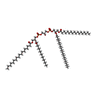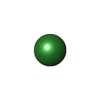[English] 日本語
 Yorodumi
Yorodumi- PDB-7z0s: Structure of the Escherichia coli formate hydrogenlyase complex (... -
+ Open data
Open data
- Basic information
Basic information
| Entry | Database: PDB / ID: 7z0s | ||||||
|---|---|---|---|---|---|---|---|
| Title | Structure of the Escherichia coli formate hydrogenlyase complex (anaerobic preparation, without formate dehydrogenase H) | ||||||
 Components Components | (Formate hydrogenlyase subunit ...) x 6 | ||||||
 Keywords Keywords |  MEMBRANE PROTEIN / FHL / group-4 membrane bound hydrogenase / [NiFe] hydrogenase MEMBRANE PROTEIN / FHL / group-4 membrane bound hydrogenase / [NiFe] hydrogenase | ||||||
| Function / homology |  Function and homology information Function and homology informationformate oxidation /  formate dehydrogenase complex / plasma membrane respiratory chain complex I / anaerobic electron transport chain / glucose catabolic process / formate dehydrogenase complex / plasma membrane respiratory chain complex I / anaerobic electron transport chain / glucose catabolic process /  anaerobic respiration / oxidoreductase activity, acting on NAD(P)H / nickel cation binding / anaerobic respiration / oxidoreductase activity, acting on NAD(P)H / nickel cation binding /  NADH dehydrogenase (ubiquinone) activity / NADH dehydrogenase (ubiquinone) activity /  quinone binding ...formate oxidation / quinone binding ...formate oxidation /  formate dehydrogenase complex / plasma membrane respiratory chain complex I / anaerobic electron transport chain / glucose catabolic process / formate dehydrogenase complex / plasma membrane respiratory chain complex I / anaerobic electron transport chain / glucose catabolic process /  anaerobic respiration / oxidoreductase activity, acting on NAD(P)H / nickel cation binding / anaerobic respiration / oxidoreductase activity, acting on NAD(P)H / nickel cation binding /  NADH dehydrogenase (ubiquinone) activity / NADH dehydrogenase (ubiquinone) activity /  quinone binding / ATP synthesis coupled electron transport / quinone binding / ATP synthesis coupled electron transport /  aerobic respiration / NAD binding / 4 iron, 4 sulfur cluster binding / membrane => GO:0016020 / aerobic respiration / NAD binding / 4 iron, 4 sulfur cluster binding / membrane => GO:0016020 /  oxidoreductase activity / oxidoreductase activity /  membrane / membrane /  metal ion binding / metal ion binding /  plasma membrane plasma membraneSimilarity search - Function | ||||||
| Biological species |   Escherichia coli K-12 (bacteria) Escherichia coli K-12 (bacteria) | ||||||
| Method |  ELECTRON MICROSCOPY / ELECTRON MICROSCOPY /  single particle reconstruction / single particle reconstruction /  cryo EM / Resolution: 2.6 Å cryo EM / Resolution: 2.6 Å | ||||||
 Authors Authors | Steinhilper, R. / Murphy, B.J. | ||||||
| Funding support |  Germany, 1items Germany, 1items
| ||||||
 Citation Citation |  Journal: Nat Commun / Year: 2022 Journal: Nat Commun / Year: 2022Title: Structure of the membrane-bound formate hydrogenlyase complex from Escherichia coli. Authors: Ralf Steinhilper / Gabriele Höff / Johann Heider / Bonnie J Murphy /  Abstract: The prototypical hydrogen-producing enzyme, the membrane-bound formate hydrogenlyase (FHL) complex from Escherichia coli, links formate oxidation at a molybdopterin-containing formate dehydrogenase ...The prototypical hydrogen-producing enzyme, the membrane-bound formate hydrogenlyase (FHL) complex from Escherichia coli, links formate oxidation at a molybdopterin-containing formate dehydrogenase to proton reduction at a [NiFe] hydrogenase. It is of intense interest due to its ability to efficiently produce H during fermentation, its reversibility, allowing H-dependent CO reduction, and its evolutionary link to respiratory complex I. FHL has been studied for over a century, but its atomic structure remains unknown. Here we report cryo-EM structures of FHL in its aerobically and anaerobically isolated forms at resolutions reaching 2.6 Å. This includes well-resolved density for conserved loops linking the soluble and membrane arms believed to be essential in coupling enzymatic turnover to ion translocation across the membrane in the complex I superfamily. We evaluate possible structural determinants of the bias toward hydrogen production over its oxidation and describe an unpredicted metal-binding site near the interface of FdhF and HycF subunits that may play a role in redox-dependent regulation of FdhF interaction with the complex. | ||||||
| History |
|
- Structure visualization
Structure visualization
| Structure viewer | Molecule:  Molmil Molmil Jmol/JSmol Jmol/JSmol |
|---|
- Downloads & links
Downloads & links
- Download
Download
| PDBx/mmCIF format |  7z0s.cif.gz 7z0s.cif.gz | 363.3 KB | Display |  PDBx/mmCIF format PDBx/mmCIF format |
|---|---|---|---|---|
| PDB format |  pdb7z0s.ent.gz pdb7z0s.ent.gz | 293.9 KB | Display |  PDB format PDB format |
| PDBx/mmJSON format |  7z0s.json.gz 7z0s.json.gz | Tree view |  PDBx/mmJSON format PDBx/mmJSON format | |
| Others |  Other downloads Other downloads |
-Validation report
| Arichive directory |  https://data.pdbj.org/pub/pdb/validation_reports/z0/7z0s https://data.pdbj.org/pub/pdb/validation_reports/z0/7z0s ftp://data.pdbj.org/pub/pdb/validation_reports/z0/7z0s ftp://data.pdbj.org/pub/pdb/validation_reports/z0/7z0s | HTTPS FTP |
|---|
-Related structure data
| Related structure data |  14429MC  7z0tC M: map data used to model this data C: citing same article ( |
|---|---|
| Similar structure data | Similarity search - Function & homology  F&H Search F&H Search |
- Links
Links
- Assembly
Assembly
| Deposited unit | 
|
|---|---|
| 1 |
|
- Components
Components
-Formate hydrogenlyase subunit ... , 6 types, 6 molecules CEBGFD
| #1: Protein | Mass: 64121.742 Da / Num. of mol.: 1 / Source method: isolated from a natural source / Source: (natural)   Escherichia coli K-12 (bacteria) / Variant: MG059e1 / Strain: K12 / References: UniProt: P16429 Escherichia coli K-12 (bacteria) / Variant: MG059e1 / Strain: K12 / References: UniProt: P16429 |
|---|---|
| #2: Protein | Mass: 66589.859 Da / Num. of mol.: 1 / Mutation: internal deca-His-Gly-Ser sequence after Gly83 Source method: isolated from a genetically manipulated source Source: (gene. exp.)   Escherichia coli K-12 (bacteria) / Strain: K12 / Gene: hycE, hevE, b2721, JW2691 / Production host: Escherichia coli K-12 (bacteria) / Strain: K12 / Gene: hycE, hevE, b2721, JW2691 / Production host:   Escherichia coli K-12 (bacteria) / Strain (production host): K12 / Variant (production host): MG059e1 / References: UniProt: P16431 Escherichia coli K-12 (bacteria) / Strain (production host): K12 / Variant (production host): MG059e1 / References: UniProt: P16431 |
| #3: Protein | Mass: 21899.289 Da / Num. of mol.: 1 / Source method: isolated from a natural source / Source: (natural)   Escherichia coli K-12 (bacteria) / Variant: MG059e1 / Strain: K12 / References: UniProt: P0AAK1 Escherichia coli K-12 (bacteria) / Variant: MG059e1 / Strain: K12 / References: UniProt: P0AAK1 |
| #4: Protein | Mass: 28033.170 Da / Num. of mol.: 1 / Source method: isolated from a natural source / Source: (natural)   Escherichia coli K-12 (bacteria) / Variant: MG059e1 / Strain: K12 / References: UniProt: P16433 Escherichia coli K-12 (bacteria) / Variant: MG059e1 / Strain: K12 / References: UniProt: P16433 |
| #5: Protein | Mass: 20336.395 Da / Num. of mol.: 1 / Source method: isolated from a natural source / Source: (natural)   Escherichia coli K-12 (bacteria) / Variant: MG059e1 / Strain: K12 / References: UniProt: P16432 Escherichia coli K-12 (bacteria) / Variant: MG059e1 / Strain: K12 / References: UniProt: P16432 |
| #6: Protein | Mass: 33049.152 Da / Num. of mol.: 1 / Source method: isolated from a natural source / Source: (natural)   Escherichia coli K-12 (bacteria) / Variant: MG059e1 / Strain: K12 / References: UniProt: P16430 Escherichia coli K-12 (bacteria) / Variant: MG059e1 / Strain: K12 / References: UniProt: P16430 |
-Non-polymers , 9 types, 124 molecules 
















| #7: Chemical | ChemComp-CDL /  Cardiolipin Cardiolipin | ||||||||||||||
|---|---|---|---|---|---|---|---|---|---|---|---|---|---|---|---|
| #8: Chemical |  Phosphatidylethanolamine Phosphatidylethanolamine#9: Chemical | ChemComp-NI / |  Nickel Nickel#10: Chemical | ChemComp-FCO / | #11: Chemical | ChemComp-DR9 / | #12: Chemical | ChemComp-SF4 /  Iron–sulfur cluster Iron–sulfur cluster#13: Chemical | ChemComp-FE / |  Iron Iron#14: Chemical | ChemComp-LMN / | #15: Water | ChemComp-HOH / |  Water Water |
-Details
| Has ligand of interest | Y |
|---|
-Experimental details
-Experiment
| Experiment | Method:  ELECTRON MICROSCOPY ELECTRON MICROSCOPY |
|---|---|
| EM experiment | Aggregation state: PARTICLE / 3D reconstruction method:  single particle reconstruction single particle reconstruction |
- Sample preparation
Sample preparation
| Component | Name: Escherichia coli formate hydrogenlyase complex without formate dehydrogenase H Type: COMPLEX / Details: Sample was prepared anaerobically / Entity ID: #1-#6 / Source: MULTIPLE SOURCES |
|---|---|
| Source (natural) | Organism:   Escherichia coli (E. coli) / Strain: K12 Escherichia coli (E. coli) / Strain: K12 |
| Buffer solution | pH: 7.5 |
| Specimen | Embedding applied: NO / Shadowing applied: NO / Staining applied : NO / Vitrification applied : NO / Vitrification applied : YES : YES |
| Specimen support | Grid material: COPPER / Grid type: C-flat-1.2/1.3 |
Vitrification | Cryogen name: ETHANE |
- Electron microscopy imaging
Electron microscopy imaging
| Experimental equipment |  Model: Titan Krios / Image courtesy: FEI Company |
|---|---|
| Microscopy | Model: FEI TITAN KRIOS |
| Electron gun | Electron source : :  FIELD EMISSION GUN / Accelerating voltage: 300 kV / Illumination mode: FLOOD BEAM FIELD EMISSION GUN / Accelerating voltage: 300 kV / Illumination mode: FLOOD BEAM |
| Electron lens | Mode: BRIGHT FIELD Bright-field microscopy / Nominal defocus max: 2500 nm / Nominal defocus min: 1000 nm / Cs Bright-field microscopy / Nominal defocus max: 2500 nm / Nominal defocus min: 1000 nm / Cs : 2.7 mm : 2.7 mm |
| Specimen holder | Specimen holder model: FEI TITAN KRIOS AUTOGRID HOLDER |
| Image recording | Electron dose: 61 e/Å2 / Film or detector model: GATAN K3 BIOQUANTUM (6k x 4k) |
- Processing
Processing
| Software | Name: PHENIX / Version: 1.19.2_4158: / Classification: refinement | ||||||||||||||||||||||||||||||||
|---|---|---|---|---|---|---|---|---|---|---|---|---|---|---|---|---|---|---|---|---|---|---|---|---|---|---|---|---|---|---|---|---|---|
| EM software |
| ||||||||||||||||||||||||||||||||
CTF correction | Type: PHASE FLIPPING AND AMPLITUDE CORRECTION | ||||||||||||||||||||||||||||||||
3D reconstruction | Resolution: 2.6 Å / Resolution method: FSC 0.143 CUT-OFF / Num. of particles: 300386 / Symmetry type: POINT | ||||||||||||||||||||||||||||||||
| Refine LS restraints |
|
 Movie
Movie Controller
Controller







 PDBj
PDBj
















